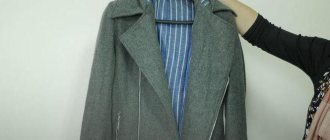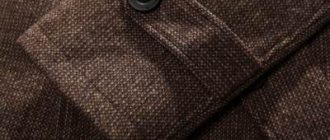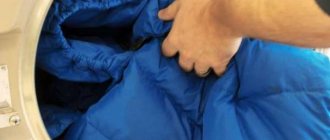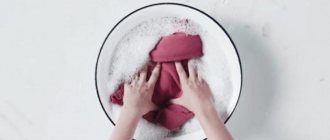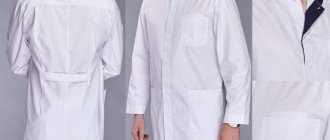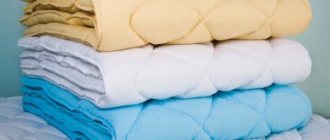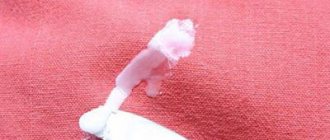To ensure that your coat always looks flawless, it requires constant care. Especially if the product is made in light colors or has a bright finish.
Dry cleaning services are expensive, and there is a risk of paying for poor quality work. A profitable alternative is to wash it yourself.
In order not to spoil the style of the coat and the structure of the fabric during the washing process, you need to follow the rules specific to the individual material.
How to wash a coat by hand so that it does not dry out, what happens if you wash the product in an automatic washing machine? Details are in the article.
Is it possible to wash a coat at home?
If the coat is made of fabric where the presence of natural fibers exceeds 60%, you should avoid washing it at home, otherwise the item will lose its shape, stretch out, or, conversely, shrink.
Also, you should not wash items made of fine camel hair, leather, suede, or models with large inserts made of these materials, otherwise the coat will be hopelessly damaged.
To avoid a fatal mistake, you should carefully study the signs on the label with instructions from the manufacturer:
- If there is a square sign with a circle inside, crossed out by two lines, then automatic washing is prohibited.
- The presence of a crossed out basin on the tag indicates that the item cannot be washed by hand. In this case, only dry cleaning can be used.
If there were stains on the coat that did not disappear after using a stain remover, it would be right to refuse to wash it yourself.
Detergent will definitely not cope with the stain; it is better to immediately take the item to dry cleaning - the services of specialists will cost less than buying a new coat.
Useful tips
Depending on what you are washing, the recommendations are different. But there is a general set of useful tips that will come in handy when cleaning any item from your wardrobe. For example, light stains on fabric are best removed with a soda solution, gently wiping them with a sponge. When washing, it is always advisable to fasten buttons, zippers, and empty pockets so that the item does not become deformed during processing and the presence of foreign objects.
It is better to organize subsequent storage of outerwear in special cases. Such covers can be transparent or colored, they are equipped with perforations and protect clothes from dust and moths. It’s better to hang things in the closet or fold them horizontally into compartments under the bed, depending on where and how you have storage.
It's best to avoid using synthetic insect repellents on your clothing. The natural material, as well as the smell of perfume and human sweat, attracts moths and other pests. Aromatic products with natural cedar extract will cope best with them. This option for protecting things from moths will not harm your health.
A coat is a must-have wardrobe item for any season and any style. Having undergone dramatic changes in shape and color throughout its history, it remains extremely popular to this day. Proper care and proper preparation for cleaning and storing it will save time and resources. With proper care, which you now know the most important thing about, outerwear will last for many years.
Preparation for the procedure
When the manufacturer indicates on the tag that washing is acceptable, you can get down to business. First of all, you need to determine how to wash it - in a washing machine or by hand.
When choosing, you should keep in mind that hand washing is always more delicate than washing in a washing machine, in which the fabric is subject to more wear and tear.
To prepare a product for washing, you should:
remove all items from pockets;- fasten all buttons, zippers, snaps and other fasteners.
- unfasten or flog existing fur;
- if present, also remove the removable hood and lining so that small areas in the fastening areas do not remain contaminated;
- Remove existing stains first using stain remover or suitable detergents, choosing them according to the type of fabric.
Stains from coffee, tea and red wine can be removed using this mixture: 1 tbsp. mix a spoonful of glycerin with 1 tbsp. spoon of ammonia.
Apply the solution to the contaminated area with a cotton swab and leave for 7-10 minutes, then rinse thoroughly with water.
In the washing machine
If the label indicates that the material contains more than 50% synthetic fibers, the coat can be washed in a washing machine.
In this case, the following rules must be observed:
first fold the product into a special mesh to make the washing process safer for the fabric (do not compact the coat too much, just wrap the floors, align the sleeves with the silhouette and fold it in half);- do not put other things on the coat, as during washing they can fade or severely deform the fabric;
- use only liquid detergents for a specific material, since the powder leaves white marks (you can also use universal mixtures “Down products”, “For soft fabrics”, etc.);
- set the water temperature to 30-40 C, usually it is indicated on the tag;
- set only the delicate washing cycle that matches the type of fabric;
- even if the manufacturer allows spinning, it is better to do without it, which will allow the material to last longer;
- Always do an extra rinse, which will guarantee a good result.
When washing, use the amount of detergent indicated on the package . Excess will only add stains to the fabric, and the quality of washing will not increase.
Do not use softeners for regular laundry, as well as bleaches with a high chlorine content. If the coat has glued parts, then during automatic washing the glue will lose its properties and they will fall off.
Features for different fabrics
When automatically washing a coat, you need to take into account the characteristics of the fabric. You should only place an item in the drum of the machine if there is a permission sign on the product label.
It is not recommended to pre-soak the coat - a long stay in water spoils the style of the product.
It is also necessary to take into account the color of the material, and choose special detergents for black or colored fabrics that can preserve the richness of the colors.
From the drape
The drape can be made from natural wool fibers or with the addition of synthetic threads - the composition of the material is indicated on the coat label. Natural drape cannot be wet ; it can only be cleaned with a soft brush.
If the drape contains mainly artificial fibers, it is allowed to wash the coat in a machine at a water temperature of +30 C, using the “hand wash” program or the delicate cycle at low speeds. Spin should be omitted and rinsed twice .
Details about a drape coat and its care are described in a separate article.
Cashmere
Cashmere is made from mountain goat fluff, so this material is especially delicate and capricious. If a coat's label says 70-100% cashmere, it shouldn't be submerged in water at all.
Automatic washing is allowed if the fabric contains less than 50% natural fibers.
High-end washing machines have a mode specifically for cashmere . If this function is missing, you need to choose a delicate method and put water at +30C.
If you just need to refresh your coat, you can wash it in cold water using a washing gel specifically for this material.
You can find out more about washing a cashmere coat in a special section.
Made from wool
Wool comes in many varieties . Fabrics such as Boston, tweed, rep and bouclé contain sheep wool. These fabrics look dense, but when immersed in water they become elastic.
Therefore, if the label indicates more than 50% natural elements, they cannot be washed, only cleaned.
The presence of synthetic threads in the fabric composition of 50% or more makes the fabric more durable and wear-resistant - such wool can be washed in a washing machine.
You need to set the washing mode to delicate, labeled “wool” , and spin at a water temperature of +30C. Do not spin, just rinse at low speed.
The features of washing a wool coat are described in detail here.
Made from polyester
Polyester is a synthetic material consisting of polyester fibers. Products made from it are practical, wear-resistant and almost do not wrinkle. A coat made from this fabric can be safely placed in the washing machine.
The main condition is that the water temperature is not higher than +40C, and if the item is not too dirty, it is better to choose +30C.
Polyester loses a lot of volume in hot water , the fabric fibers lose their strong structure, so it must be washed in a delicate mode. You can use the “spin” function, but set it to no more than 400 rpm.
Be sure to add a mild conditioner to the liquid detergent, which will rid the fabric of static electricity.
On padding polyester
Sintepon is a non-woven material that is a synthetic insulation:
- It can only be washed in warm water (+30-40 C), in the “delicate” or “hand wash” modes.
- It is absolutely forbidden to soak things on padding polyester.
- Do not spin; it is better to rinse twice.
Made from holofiber
Holofiber is an improved filler with a more porous structure than synthetic padding. He is less capricious in care .
If it is heavily soiled, it can be washed in hot water (up to +60 C), spin speed up to 600 rpm. If you just need to refresh your coat, it is better to take care of the fabric and wash it in warm water +30 C.
To avoid the filler from rolling off, you should put 3-4 wash balls in the drum . Before use, make sure that the paint on the balls does not fade.
From a mixed composition
If the coat has a mixed composition, its components are indicated in detail on the product label. For washing, the “hand wash” or delicate function is usually recommended.
The water temperature should be set no higher than +30 C, and the spin should be turned off . You need to rinse such a coat at low speed.
Only coats made of polyester can be turned inside out before washing; other coats should be placed face down in the mesh to prevent streaks.
Polyester coats with fillings should not be washed frequently. During the washing process, the water-repellent impregnation is washed out, which leads to a loss of strength of the synthetic fiber. In this case, the coat quickly gets wet and loses its style.
How to wash by hand at home?
If the sign on the label indicates that washing in a washing machine is prohibited, you must use the manual method.
To do this , you should choose a container that is suitable in size - the coat should be completely immersed in water and not shrink too much, then the product will be washed evenly and there will be no unnecessary creases.
Hand wash procedure:
Pour a sufficient amount of warm water into the container (not higher than +30 C).- Add liquid detergent in the amount indicated on the package and mix thoroughly.
- Immerse the product in the prepared water until completely wet.
- Using gentle movements, lightly squeeze the fabric over the entire area (do not rub the contaminated areas intensively, otherwise pellets will appear, and the color of the material may also change).
- Wash quickly so that the item remains in soapy water for as little time as possible.
- After washing, rinse immediately, trying to transfer the coat from the basin without stretching it.
- Rinse with plenty of cool water without lifting the coat to the surface, otherwise the item may become deformed.
When hand washing, only polyester coats with holofiber filling can be pre-soaked. This should be done in case of severe contamination and for no more than 15-20 minutes.
How to dry it properly?
Automatic drying can only be used for coats made of polyester with down filling. Along with the product, you need to place laundry balls in the drum so that the fluff is evenly distributed in the cells. Dry for no longer than 1.5 hours at a temperature of +30 C.
It is recommended to dry models made from other fabrics in the following way:
prepare a suitable horizontal platform for drying and cover it with a soft, non-fading cloth;- lay out the product evenly, straightening out the creases and wait until the water drains;
- after abundant drainage of water, also transfer the coat horizontally onto a dry, thick cloth (a terry sheet or large towel will do), smoothing out all the details with your hands;
- choose the right place for drying - it should be a spacious, warm room with good ventilation (you cannot leave it in the bathroom, there the item will acquire a musty smell);
- when the coat becomes slightly damp, you can hang it on hangers and keep it away from heating devices;
- drying in the fresh air is allowed in warm weather up to +18 C (not allowed in hot weather), without direct exposure to sunlight;
- finish drying in time, if necessary, iron the item with a warm iron through gauze or thin fabric (the coat cannot be overdried, in this case the item is guaranteed to shrink and the material will lose its smoothness).
The coat should not be dried for a long time and in places with high humidity, otherwise the fibers of the fabric and sewing threads will begin to rot and rot, which will lead to damage to the product and an unpleasant smell.
Drying Features
The ideal drying option is on a mannequin. But who always has a mannequin in their house, and of the right size at that? Therefore, you will have to make do with a hanger. During drying, the product should not touch anything, be near heating devices or in a stream of directed hot air. The hanger should imitate the shape of a shoulder, that is, thin wire hangers will not work; you need ones with wide hangers.
If it’s really hard to find hangers and drying space in a vertical position, then you can get by with a horizontal surface. It should be smooth and uniform, and the coat should be laid out according to the shape. Drying clothes is not suitable, the ropes will leave marks, which will then be very difficult to remove without re-washing. The backing should be white and clean, and changed every time it gets wet. Therefore, it is better to leave the drainage after washing your coat in the bathroom. The product must be turned over every two hours.
If the product shrinks after washing, what should you do?
The main reasons for coat shrinkage after home washing are:
incorrect choice of detergent;- washing without taking into account the characteristics of the material;
- water hotter than permissible (must be within +30 C);
- sudden temperature changes (when the water during washing is much warmer than during rinsing);
- automatic or manual aggressive spin;
- violation of drying rules.
If mistakes have already been made and the coat has decreased in size, there are ways to return it to its original appearance :
- Method number 1 .
You will need the following solution: for 5 liters of warm water (+15-20 C) you will need 2 tbsp. spoons of soda. Pour enough solution into a basin of suitable size so that the coat is completely submerged. Leave the product for 30 minutes, then rinse thoroughly in water at the same temperature. Lay the item horizontally, without squeezing, and carefully stretch it to the desired size. Repeat gentle stretching during the drying process, and when the material becomes barely damp, steam it well and dry it vertically, hanging it on a hanger. - Method number 2 .
For it you will need the following mixture: for 10 liters of cold water – 6 tbsp. spoons of ammonia and 5 tbsp. spoons of turpentine. Mix the ingredients well and place the coat there for 40 minutes. This solution perfectly softens fabric fibers and makes them elastic. After the procedure, rinse the item thoroughly in cold water and lay it out horizontally. After 10 minutes, pull out the coat, repeating the procedure until completely dry, and then, if necessary, iron through a thin fabric. - Method number 3 .
This method is good for delicate cashmere and fine wool. Stir hair conditioner in cold water (for 10 liters you will need 2 tablespoons). Soak the shrunken coat in this mixture for 25-30 minutes, then rinse in cool water. Lay it out on a horizontal surface, but do not wring out the fabric. Then smooth the product with your hands and begin to stretch it, first in breadth, and then along the fibers. Repeat stretching periodically until drying is complete.
If the coat shrinks slightly, it will be enough to steam it thoroughly. To do this, hang the item on hangers (optimally on a mannequin), and steam with an iron from all sides, working from top to bottom.
How to avoid shrinkage in the future
Fabric deformation such as shrinkage negatively affects the appearance of the product and is not easy to eliminate. The advantage of dry cleaning is that they return the product to the desired size using an inflatable mannequin .
The item is put on it and, as it dries, the required amount of air is added, after which it is thoroughly steamed.
In household use, a simple mannequin is a rarity. Therefore, in order to avoid future shrinkage of the coat, you should not act at random when washing, but carefully study the features of the material from which this model is made.
Useful information about washing outerwear is presented in this section.
Selecting a detergent
Some housewives do not know that coats cannot be washed with standard powder. Powder particles may settle on the fabric, causing streaks. Before washing your outerwear, you should study various detergents and purchase the right one.
Some tips for choosing a detergent:
- For delicate cleansing, liquid and gel products are suitable. They are well washed out of the fabric fibers without leaving streaks.
- If there are small stains on the fabric, then the stain removers from the Dr. Beckmann line can handle them.
- For hand washing, it is recommended to use a soap solution. It is safe not only for fabric, but also for the skin of your hands.
- Products containing chlorine or active oxygen must not be used in washing.
- The best detergents for washing outerwear are gels and capsules intended for children's clothes.
- Before purchasing powder, you should pay attention to the recommendations for the color of the product. Color detergent will not damage white fabric, but white fabric detergent may negatively affect the vibrancy of the colors.
